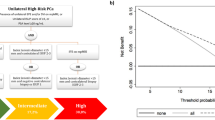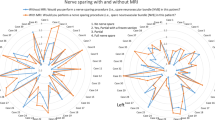Abstract
Objective
To investigate the oncologic safety of neurovascular bundles (NVB) preservation at radical prostatectomy (RP) in patients with high-risk and/or locally advanced prostate cancer (PCa).
Material and methods
Within a two-institutional high-volume center database we identified patients who harbored high-risk PCa at RP (2000–2017). Only patients with D’Amico high-risk PCa were included. Kaplan–Meier and multivariable Cox regression models tested the effect of NVB preservation on biochemical recurrence (BCR), metastasis and overall survival (OS). Subgroup analyses focused on patients with clinical stage T3 and/or biopsy ISUP grade 5 and pathologic stage T3.
Results
Of 4351 patients with D’Amico high-risk, 35.7% vs. 38.0% vs. 26.3% underwent bilateral vs. unilateral vs. no NVB preservation, respectively. At 120 months after RP BCR-free, metastasis-free survival and OS rates were 62.2% vs. 44.3% vs. 27.1% (p < 0.001), 83.7% vs. 66.7% vs. 60.3% (p < 0.001), and 91.8% vs. 87.5% vs. 72.3% (p < 0.001) for bilateral vs. unilateral vs. no NVB preservation, respectively. In multivariable Cox regression models, bilateral and unilateral compared to no NVB preservation did not increase the risk for BCR, metastasis or death in the entire cohort and in subgroups with clinical stage T3 and/or biopsy ISUP grade 5, as well as pathologic stage T3.
Conclusions
NVB preservation was not associated with worse oncological outcome in patients with high-risk and/or locally advanced PCa and may be offered to well-selected patients who are at risk of harboring nonorgan-confined PCa.
This is a preview of subscription content, access via your institution
Access options
Subscribe to this journal
Receive 4 print issues and online access
$259.00 per year
only $64.75 per issue
Buy this article
- Purchase on Springer Link
- Instant access to full article PDF
Prices may be subject to local taxes which are calculated during checkout



Similar content being viewed by others
References
Joniau SG, Van Baelen AA, Hsu CY, Van Poppel HP. Complications and functional results of surgery for locally advanced prostate cancer. Adv Urol. 2012;2012:706309.
Loeb S, Smith ND, Roehl KA, Catalona WJ. Intermediate-term potency, continence, and survival outcomes of radical prostatectomy for clinically high-risk or locally advanced prostate cancer. Urology. 2007;69:1170–5.
Beyer B, Schlomm T, Tennstedt P, Boehm K, Adam M, Schiffmann J, et al. A feasible and time-efficient adaptation of NeuroSAFE for da Vinci robot-assisted radical prostatectomy. Eur Urol. 2014;66:138–44.
Kumar A, Samavedi S, Bates AS, Mouraviev V, Coelho RF, Rocco B, et al. Safety of selective nerve sparing in high risk prostate cancer during robot-assisted radical prostatectomy. J Robot Surg. 2017;11:129–38.
Quinlan DM, Epstein JI, Carter BS, Walsh PC. Sexual function following radical prostatectomy: influence of preservation of neurovascular bundles. J Urol. 1991;145:998–1002.
Michl UHG, Friedrich MG, Graefen M, Haese A, Heinzer H, Huland H. Prediction of postoperative sexual function after nerve sparing radical retropubic prostatectomy. J Urol. 2006;176:227–31.
Graefen M, Walz J, Huland H. Open retropubic nerve-sparing radical prostatectomy. Eur Urol. 2006;49:38–48.
Michl U, Tennstedt P, Feldmeier L, Mandel P, Oh SJ, Ahyai S, et al. Nerve-sparing surgery technique, not the preservation of the neurovascular bundles, leads to improved long-term continence rates after radical prostatectomy. Eur Urol. 2016;69:584–9.
Steineck G, Bjartell A, Hugosson J, Axén E, Carlsson S, Stranne J, et al. Degree of preservation of the neurovascular bundles during radical prostatectomy and urinary continence 1 year after surgery. Eur Urol. 2015;67:559–68.
Mottet N, Cornford P, van den Bergh RCN, Briers E, De Santis M, Fanti S, et al. EAU—ESTRO—ESUR—SIOG guidelines on prostate cancer. Arnhem, The Netherlands: EAU Guidelines Office; 2020.
Schlomm T, Tennstedt P, Huxhold C, Steuber T, Salomon G, Michl U, et al. Neurovascular structure-adjacent frozen-section examination (NeuroSAFE) increases nerve-sparing frequency and reduces positive surgical margins in open and robot-assisted laparoscopic radical prostatectomy: experience after 11,069 consecutive patients. Eur Urol. 2012;62:333–40.
Lavery HJ, Nabizada-Pace F, Carlucci JR, Brajtbord JS, Samadi DB. Nerve-sparing robotic prostatectomy in preoperatively high-risk patients is safe and efficacious. Urol Oncol Semin Orig Investig. 2012;30:26–32.
Gandaglia G, De Lorenzis E, Novara G, Fossati N, De Groote R, Dovey Z, et al. Robot-assisted radical prostatectomy and extended pelvic lymph node dissection in patients with locally-advanced prostate cancer. Eur Urol. 2017;71:249–56.
Budäus L, Isbarn H, Schlomm T, Heinzer H, Haese A, Steuber T, et al. Current technique of open intrafascial nerve-sparing retropubic prostatectomy. Eur Urol. 2009;56:317–24.
Preston MA, Breau RH, Lantz AG, Morash C, Gerridzen RG, Doucette S, et al. The association between nerve sparing and a positive surgical margin during radical prostatectomy. Urol Oncol Semin Orig Investig. 2015;33:18.e1–6.
Liss M, Osann K, Ornstein D. Positive surgical margins during robotic radical prostatectomy: a contemporary analysis of risk factors. BJU Int. 2008;102:603–8.
Røder MA, Thomsen FB, Berg KD, Christensen IBJ, Brasso K, Vainer B, et al. Risk of biochemical recurrence and positive surgical margins in patients with pT2 prostate cancer undergoing radical prostatectomy. J Surg Oncol. 2014;109:132–8.
Zhang L, Wu B, Zha Z, Zhao H, Yuan J, Jiang Y, et al. Surgical margin status and its impact on prostate cancer prognosis after radical prostatectomy: a meta-analysis. World J Urol. 2018;36:1803–15.
Yossepowitch O, Bjartell A, Eastham JA, Graefen M, Guillonneau BD, Karakiewicz PI, et al. Positive surgical margins in radical prostatectomy: outlining the problem and its long-term consequences. Eur Urol. 2009;55:87–99.
Graefen M, Haese A, Pichlmeier U, Hammerer PG, Noldus J, Butz K, et al. A validated strategy for side specific prediction of organ confined prostate cancer: a tool to select for nerve sparing radical prostatectomy. J Urol. 2001;165:857–63.
Palisaar R-J, Noldus J, Graefen M, Erbersdobler A, Haese A, Huland H. Influence of nerve-sparing (NS) procedure during radical prostatectomy (RP) on margin status and biochemical failure. Eur Urol. 2005;47:176–84.
Author information
Authors and Affiliations
Corresponding author
Ethics declarations
Conflict of interest
The authors declare that they have no conflict of interest.
Additional information
Publisher’s note Springer Nature remains neutral with regard to jurisdictional claims in published maps and institutional affiliations.
Supplementary information
Rights and permissions
About this article
Cite this article
Preisser, F., Gandaglia, G., Arad, F. et al. Association of neurovascular bundle preservation with oncological outcomes in patients with high-risk prostate cancer. Prostate Cancer Prostatic Dis 24, 193–201 (2021). https://doi.org/10.1038/s41391-020-00266-4
Received:
Revised:
Accepted:
Published:
Issue Date:
DOI: https://doi.org/10.1038/s41391-020-00266-4



